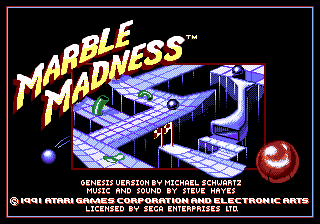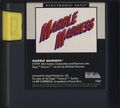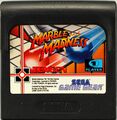Difference between revisions of "Marble Madness"
From Sega Retro
| Line 44: | Line 44: | ||
'''''Marble Madness''''' (マーブルマッドネス) is an arcade game developed by [[Atari]] which was subsequently brought to the [[Sega Mega Drive]], [[Sega Master System]] and [[Sega Game Gear]] in 1991, 1992 and 1992 respectively. | '''''Marble Madness''''' (マーブルマッドネス) is an arcade game developed by [[Atari]] which was subsequently brought to the [[Sega Mega Drive]], [[Sega Master System]] and [[Sega Game Gear]] in 1991, 1992 and 1992 respectively. | ||
| − | The object of the game is to move a marble down an isometric field from one point to another, making sure not to fall of ledges or be damaged in other ways. The original arcade release relied heavily on a trackball controller, but the console ports rely on | + | ==Gameplay== |
| + | The object of the game is to move a marble down an isometric field from one point to another, making sure not to fall of ledges or be damaged in other ways. The original arcade release relied heavily on a trackball controller, but the console ports rely on directional pad, meaning the control is less accurate. On the Mega Drive, the D-pad moves the ball in the on-screen direction of the button press. For example, {{up}} will move the marble vertically up on the screen, with the respective effect in the arena. | ||
==Physical Scans== | ==Physical Scans== | ||
Revision as of 23:31, 27 November 2010
| Marble Madness |
|---|
| System(s): Sega Mega Drive, Sega Master System, Sega Game Gear |
| Publisher: Electronic Arts, Tengen (JP) Virgin Interactive Tengen |
| Developer: Atari, Domark |
| Genre: Puzzle |
| Number of players: 1 |
Marble Madness (マーブルマッドネス) is an arcade game developed by Atari which was subsequently brought to the Sega Mega Drive, Sega Master System and Sega Game Gear in 1991, 1992 and 1992 respectively.
Contents
Gameplay
The object of the game is to move a marble down an isometric field from one point to another, making sure not to fall of ledges or be damaged in other ways. The original arcade release relied heavily on a trackball controller, but the console ports rely on directional pad, meaning the control is less accurate. On the Mega Drive, the D-pad moves the ball in the on-screen direction of the button press. For example, ![]() will move the marble vertically up on the screen, with the respective effect in the arena.
will move the marble vertically up on the screen, with the respective effect in the arena.








